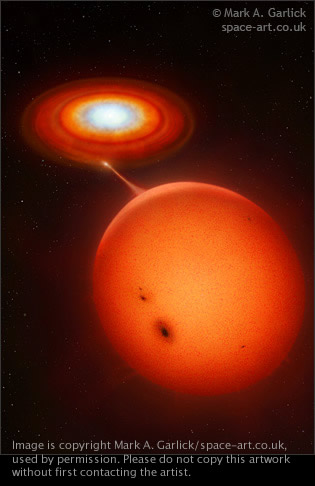Cataclysmic Variable Research
 Cataclysmic variables (CVs) are close interacting binary star systems in which mass typically flows from a low-mass main-sequence secondary star to a white dwarf star. These pages give a brief overview of the work we're doing. Originally we were going to include a full site devoted to discussion of all things CV, but that would duplicate (poorly) what is already available online (Wikipedia,CVCat, CV Beginner's Guide, NASA HEASARC E/PO), and in the well-written and comprehensive books by Brian Warner and Coel Hellier (both are must-reads, but the latter is more accessible to the non-specialist). No CVs have been directly imaged - they're much to small and distant - but Mark Garlick is an artist who's created some amazing conceptions of CVs and related objects (see image at right).
Cataclysmic variables (CVs) are close interacting binary star systems in which mass typically flows from a low-mass main-sequence secondary star to a white dwarf star. These pages give a brief overview of the work we're doing. Originally we were going to include a full site devoted to discussion of all things CV, but that would duplicate (poorly) what is already available online (Wikipedia,CVCat, CV Beginner's Guide, NASA HEASARC E/PO), and in the well-written and comprehensive books by Brian Warner and Coel Hellier (both are must-reads, but the latter is more accessible to the non-specialist). No CVs have been directly imaged - they're much to small and distant - but Mark Garlick is an artist who's created some amazing conceptions of CVs and related objects (see image at right).
We model CVs using the method of smoothed particle hydrodynamics (SPH), a Lagrangian numerical fluid dynamics method. You can download the Fortran source code for our DiskSim at ascl.net/1811.013. See the visualization page for animations of CV superhumps.
Since October 2024, I've been the Scientific Director of the Center for Backyard Astrophysics (CBA; cbastro.org). The CBA is a global network of mostly amateur astronomers, and thus is a very successful example of Citizen Science. Our observers are a cadre of dedicated and skilled amateur astronomers from around the globe devoted to the study of periods and periodicities of CVs. We have over 65,000 data sets in our repository dating back some 30 years, and our observers are submitting over 3000 data sets per year, averaging over the past 10 years! Are you an amateur astronomer who's mastered astrophography and now wants a new challenge? Please email me and we will get you started! Are you a professional astronomer who would like to receive hundreds of hours of photometry on a favorite object? Please email me and we'll get you those data sets. We only ask that the obsevers who contribute significant amounts of data (e.g., at least 5-10 hours) be included as co-authors on the resulting papers. They spend their own funds to purchase their equipment and give generously of their time to obtain and reduce the data for no monetary compensation - co-authorship is their reward.
If you'd like to run some numerical simulations of your own, please download FITDisk, which is a user-friendly demonstration version of our research code. This is an older binary for Windows machines, so may not work under more recent Windows OS versions.
This was supported in part by the National Science Foundation through grants AST-0205902, AST-0552798, AST-1109332, AST-1305799, and AST-1726357.
